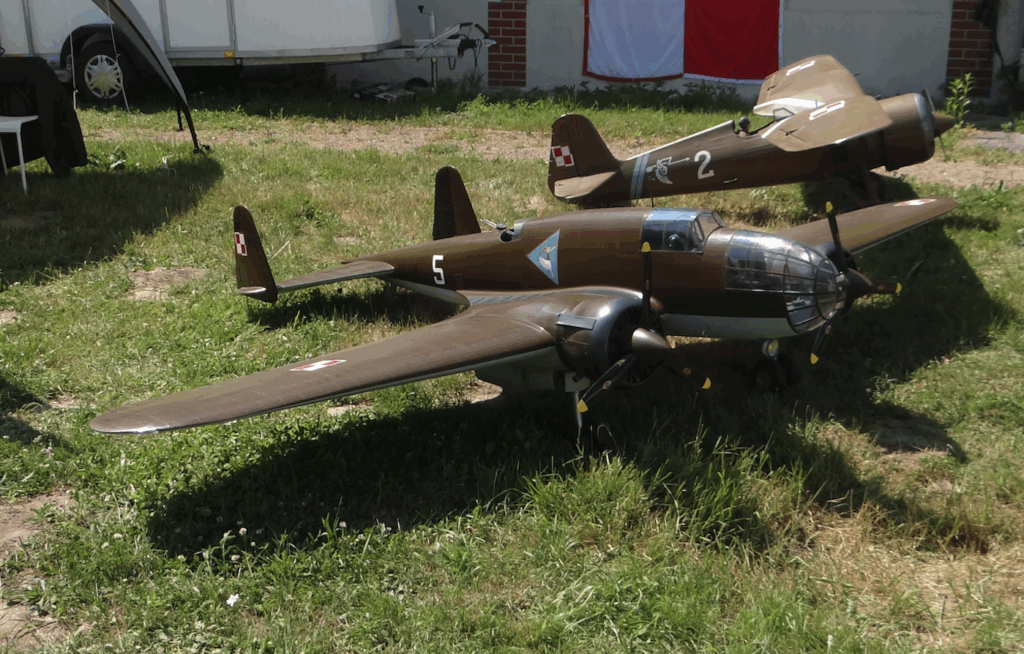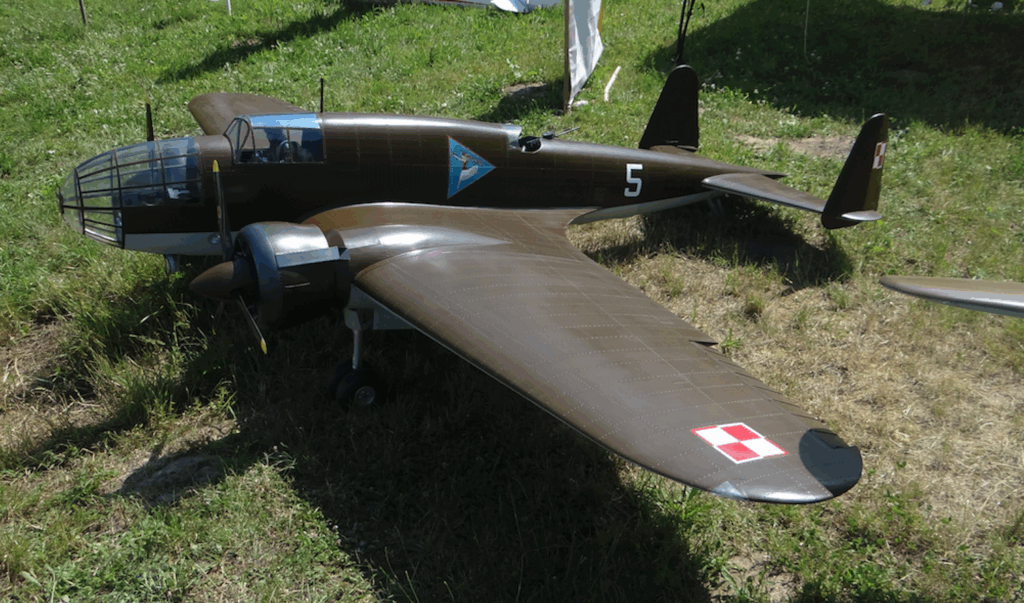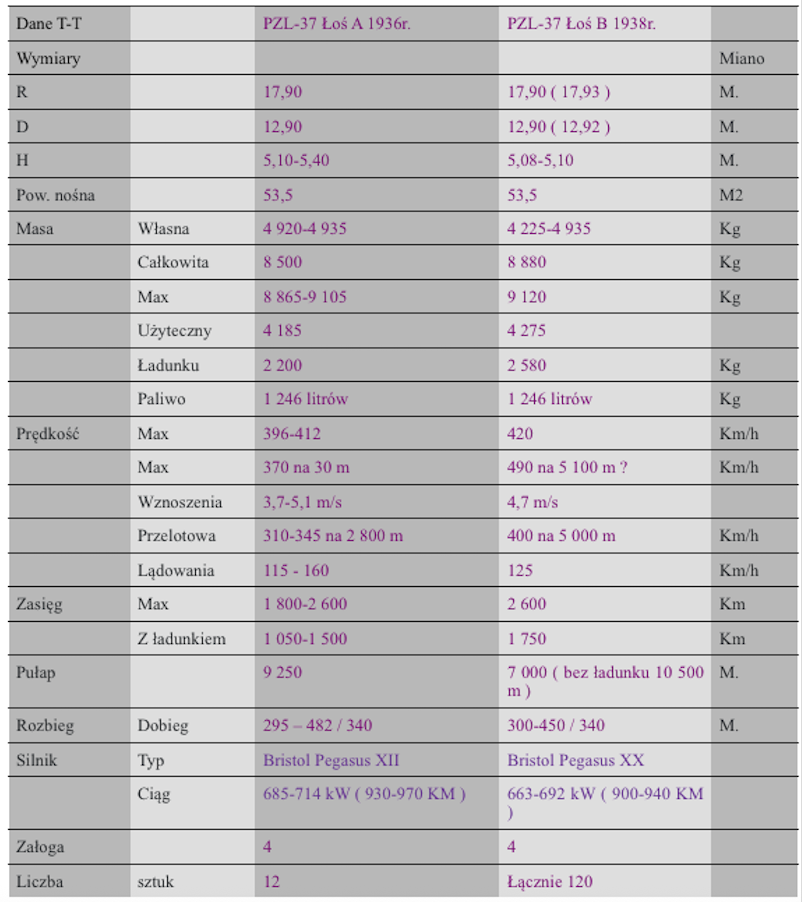Krakow, November 1, 2012
PZL PZL-37 Łoś.
Section 1936-12-13. Bomber aircraft.



Design.
The PZL-37 Łoś is a medium bomber aircraft designed for daylight flights. Built in 1936. In 1937, the aircraft began to be introduced into the Bomber Squadrons. The crew consisted of four pilots.
Aircraft wing.
The wing is a three-section, trapezoidal-elliptical wing with smooth, working skin, and a two-spar design. The wing is made entirely of aluminum alloy, consisting of a center wing and external attachments. The center wing terminates behind the engine nacelles and main landing gear bays. The center wing is a box-shaped structure, partially open at the bottom, housing the wing bomb bays. The bomb bays are equipped with bomb attachment points, interchangeable depending on the bomb load. The skin is made of grooved aluminum alloy sheet metal, secured with flat-head rivets. The outer wing sections are constructed using identical technology. Their leading edges feature automatic two-section slats, locked by the pilot. The trailing edge of the wing, on the outside, is equipped with classic slotted ailerons, without trim tabs. Only small blades are used, which can be manually adjusted before flight. The remainder of the trailing wing is equipped with two-section crocodile-type flaps. The flaps are pneumatically extended and hydraulically retracted. A launcher housing four signal or illumination flares is mounted at the end of the starboard wing. A walkway along the starboard side provides access to the forward cabin. The wings have a JD 12/P-37 laminar airfoil.
The fuselage.
The fuselage is of semi-monocoque construction, with a contour similar to the wing profile, both in horizontal and vertical cross-sections. The cross-section is oval. The fuselage is all-metal. The base consists of duralumin frames, to which stringers with a “Z” cross-section are attached. The entire structure is covered with duralumin sheeting, ranging from 0.8 mm to 2.0 mm thick.
The nose of the fuselage is richly glazed. This is where the crew commander’s station is located. He served as pilot, observer, navigator, bombardier, and nose gunner. He had bomber sights, a single machine gun, controls (slightly offset to the right), basic navigation instruments, and other equipment.
The pilot’s station was located in the upper part of the fuselage. The glazing consists of a fixed windshield and a port-hinged fairing with numerous windows. The upper windows are tinted blue or blue-green. The fairing can be easily folded down in an emergency. The pilot’s seat is slightly offset to the left of the cockpit. The pilot has control levers and adjustable pedals. Both the commander and pilot boarded the aircraft through the cockpit fairing. The commander boarded first. When both piloted, they used most of the common avionics instruments.
Behind the cockpit was the radio operator/gunner’s station. He has a licensed Polish-made Philips N1L/L radio. Additionally, he has a barometric altimeter, airspeed indicator, clock, and other instruments. An antenna stand with a pitot probe is located on the fuselage dorsal. The bomb bay is located in the lower fuselage, closed by a two-part door. The lower and upper gunner’s stations are located at the rear of the fuselage. The crew cabins are heated.
Aircraft Tail.
The prototype (PZL-37/I) and the first ten examples (PZL-37 A) featured a classic tail with a single vertical tail. All other aircraft were fitted with an “H”-shaped tail (with two vertical tails). The main goal of this modification was to improve the field of fire for the rear-upper gunner. The tail is a cantilever, double-spar, duralumin construction, covered with smooth sheet metal. Each tail consists of a rudder and a stabilizer. The elevators are equipped with trimmers.
Aircraft Landing Gear.
The prototype was built with a main landing gear with single wheels on twin struts. However, during landings in rough terrain, it turned out that the landing gear was hard and the aircraft did not cope well with all the uneven surfaces. Therefore, the landing gear was redesigned. The new landing gear was developed by engineer Piotr Kubicki. For the first time in the world, an independent suspension system with twin wheels was used. This allowed them to operate independently on uneven terrain. Each wheel could steer individually. This allowed not only typical operations from field airfields but also safe landings even in potato fields. The landing gear proved to be excellent and was patented by PZL – Polish Patent No. 29090.
The landing gear wheelbase was approximately 5 m. The suspension was oil-air shock absorbers from Avia. Tires were 755 x 440. Dunlop hydraulic brakes. The landing gear retracted hydraulically. In the prototype, the landing gear was mechanically retracted using a crank handle. Mechanical landing gear extension and retraction indicators, sometimes called “soldiers,” were located on the upper surface of the nacelle. The rear skid was a PZL system with an auxiliary metal roller, self-adjusting, and fitted with an oil-air shock absorber from Avia.
Powertrain
Propulsion was provided by two excellent, 9-cylinder, single-star, turbocharged engines, manufactured by Bristol, Pegasus type. These engines were also manufactured under license in Poland. Engine diameter: 1.404 m, weight: 467 kg. Hamilton Standard propellers: 3-blade, metal, adjustable, with two-position capability. Diameter: 3.50 m. Fuel: 87 octane. Starting: Avia-Eclipse 11A electric inertia starter. The engines are protected by duralumin cowls.
Bristol Pegasus XII engine with a takeoff power of 685-714 kW (930-970 hp) at 2,475 rpm. Nominal power of 604-633 kW (820-860 hp) at 2,250 rpm at an altitude of 1,220 m.
Bristol Pegasus XX with a takeoff power of 663-692 kW (900-940 hp) at 2,600 rpm. Nominal power of 597-626 kW (810-850 hp) at 2,250 rpm at an altitude of 2,600 m.
Bristol Pegasus XIX – differs from the Pegasus XX only in the reduction gear.
Bristol Perseus X – an experimental valveless engine with a nominal power of 516-538 kW (700-730 hp) and a maximum power of 648 kW (880 hp). These engines were installed on two aircraft for test purposes in 1939.
Gnome-Rhône 14 N 00/01 – a double-radial engine with a nominal power of 700 kW (950 hp) and a maximum power of 722-751 kW (980-1,020 hp), used only on units offered for export. They were installed on the PZL-37/III and PZL-37C aircraft.
Gnôme-Rhône 14 N 20/21 – a double-radial engine with a nominal power of 758 kW (1,030 hp) and a maximum power of 810 kW (1,100 hp). They were installed on the PZL-37 D.
Fuel tanks.
The aircraft was equipped with five tanks located in the airframe. The first tank was located under the cockpit (capacity 532 liters). Two tanks were located in the center wing roots (capacity 2 x 238 liters). Two tanks were located behind the engines (capacity 2 x 119 liters). A total of 1,246 liters, or 945 kg. Two tanks could be installed in the bomb bay, each with a capacity of 2 x 369 liters. The oil system consisted of two tanks in the engine nacelles, each with a capacity of 2 x 115 liters.
Aircraft armament.
The defensive armament on the Łoś A and A bis aircraft initially consisted of Vickers F machine guns. Later, PWU wz. 37 Szczeniak machine guns with FK wz. 37 sights were standard. 38. Three movable machine guns are mounted, placed in firing positions: forward, lower, and rear. Field of fire: front machine gun – up and sides up to 25 degrees, down 45 degrees. Upper rear machine gun – up 60 degrees, down 10 degrees, side to side 85 degrees each. Lower rear machine gun – down and sides up to 60 degrees.
PZO RH-32 and Goertz-Boykov bombsight. The aircraft carries a maximum payload of 2,595 kg. Nominal payload is 2,200 kg. Typically, the aircraft carries up to 20 bombs weighing 100–110 kg. Other typical arrangements include 20 bombs of 50 kg each, 18 bombs of 100–110 kg each, and 2 bombs of 300 kg each. The bomb bays feature double-decker mechanical-electric launchers.
Data from the T-T PZL-37 Łoś.

Written by Karol Placha Hetman

